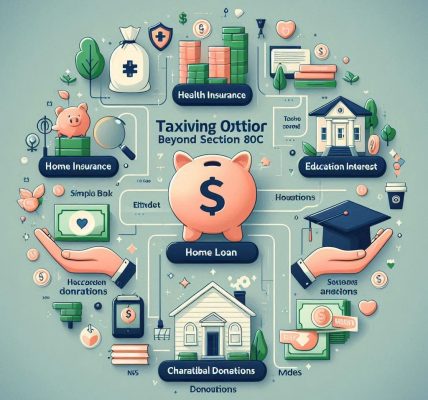Tax planning is an essential part of personal finance, especially for salaried individuals who seek to optimize their income by legally minimizing their tax burden. In this comprehensive guide, we will explore smart and legal tax-saving strategies that can help you maximize your take-home salary while staying compliant with tax regulations.
1. Understanding Your Tax Slab
The first step in effective tax planning is understanding the income tax slabs and rates applicable for the current financial year. These slabs are defined based on income levels and differ based on the tax regime chosen (Old Tax Regime vs. New Tax Regime). Stay updated with any changes announced in the latest budget to ensure accurate tax calculations.
- Old Tax Regime: Allows multiple deductions and exemptions.
- New Tax Regime: Offers lower tax rates but fewer deductions.
Before choosing between the two, compare which option results in lower tax liability for you.
2. Maximizing Tax Deductions Under Section 80C
Section 80C allows deductions of up to ₹1.5 lakh on specific investments and expenses. Some of the best tax-saving options under this section include:
Investment-Based Deductions
- Employees’ Provident Fund (EPF) – Automatically deducted for salaried employees.
- Public Provident Fund (PPF) – A long-term, tax-free savings option.
- National Savings Certificate (NSC) – A secure investment with guaranteed returns.
- Tax-Saving Fixed Deposits – Offered by banks with a lock-in period of 5 years.
- Equity-Linked Savings Scheme (ELSS) – Market-linked mutual funds with tax benefits.
- Sukanya Samriddhi Yojana (SSY) – A special scheme for a girl child’s future.
- Life Insurance Premiums – Premiums paid for life insurance policies qualify for deductions.
Expense-Based Deductions
- Children’s Tuition Fees – Up to ₹1.5 lakh per year for two children.
- Home Loan Principal Repayment – If you have a home loan, its principal repayment qualifies for tax benefits.
3. Availing Additional Deductions Under Sections 80D, 80E, and 80G
Apart from 80C, other deductions help in reducing your taxable income:
- Section 80D – Health Insurance Premiums: Up to ₹25,000 for self, spouse, and children (₹50,000 for senior citizens).
- Section 80E – Education Loan Interest: No upper limit on interest deduction.
- Section 80G – Donations to Charity: Tax deductions based on the percentage of donation.
4. Maximizing HRA (House Rent Allowance) Exemptions
If you live in a rented house, you can claim HRA exemptions based on:
- Actual HRA received from your employer.
- Rent paid minus 10% of basic salary.
- 50% of basic salary (for metro cities) or 40% (for non-metro cities).
Submit rent receipts to your employer to claim HRA benefits and avoid paying unnecessary taxes.
5. Save Tax Through Home Loan Benefits
Owning a home can provide significant tax savings:
- Principal repayment (Section 80C) – Up to ₹1.5 lakh deduction.
- Home loan interest (Section 24b) – Up to ₹2 lakh deduction on interest paid.
- Additional ₹1.5 lakh deduction (Section 80EEA) for first-time homebuyers.
These deductions can reduce your tax burden significantly while helping you build a valuable asset.
6. Tax Benefits on NPS Contributions
The National Pension System (NPS) is a great tool for long-term savings and tax benefits:
- Section 80CCD(1): Up to ₹1.5 lakh deduction.
- Section 80CCD(1B): Additional ₹50,000 deduction.
- Section 80CCD(2): Employer’s NPS contribution is tax-exempt up to 10% of basic salary.
This means you can save up to ₹2 lakh annually while securing your retirement.
7. Utilizing the Standard Deduction
The government allows a standard deduction of ₹50,000 for salaried individuals. This deduction applies automatically when filing your tax return, reducing taxable income without any investment requirements.
8. Salary Restructuring for Better Tax Efficiency
You can restructure your salary components for tax optimization. Some tax-free allowances include:
- Meal Coupons – Up to ₹2,400 per month.
- Leave Travel Allowance (LTA) – Tax-free for domestic travel expenses.
- Fuel and Driver Salary Reimbursements – Tax-free if included in salary structure.
Consult with your employer to optimize your salary structure for maximum tax savings.
9. Filing Your Income Tax Returns (ITR) Smartly
Filing your ITR on time ensures that you:
- Avoid late filing penalties.
- Get tax refunds faster.
- Stay compliant with tax laws.
Use government-approved portals like the Income Tax e-filing website or authorized tax-filing platforms.
10. Avoiding Common Tax Mistakes
To ensure smooth tax planning, avoid these mistakes:
- Failing to declare other sources of income (e.g., interest on savings accounts, rental income).
- Missing out on deductions due to lack of proper documentation.
- Selecting the wrong tax regime without proper analysis.
- Delaying tax filing beyond the due date.
By keeping records and staying informed, you can stay legally safe while minimizing taxes.
Final Thoughts
Smart tax-saving strategies require proper planning, documentation, and awareness of tax laws. By using legal tax-saving options, salaried individuals can optimize their tax liability and increase their savings. Always consult a tax professional if you are unsure about any deductions or exemptions.
By implementing these strategies, you can save thousands in taxes while staying fully compliant with the law. Happy tax planning!




